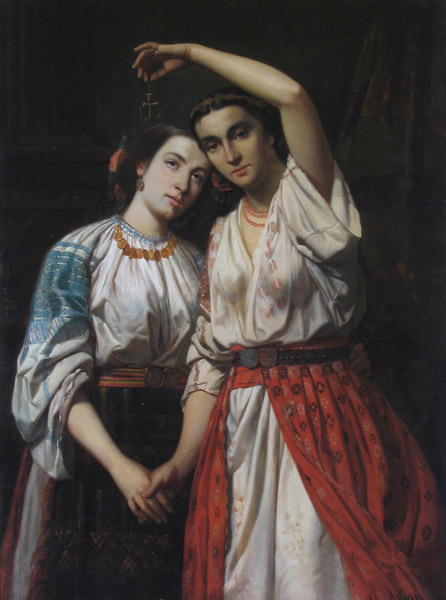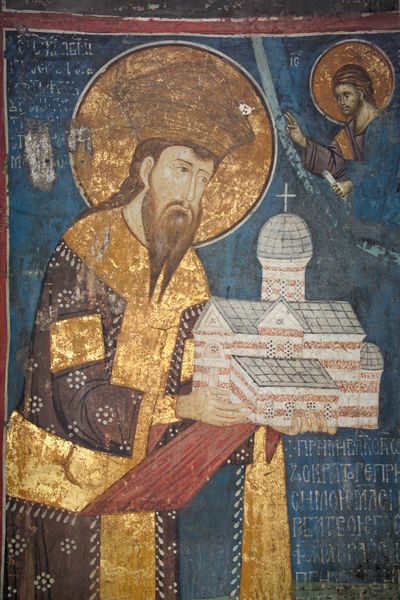|
Church Of The Prophet Samuel, Focșani
The Church of the Prophet Samuel () is a Romanian Orthodox church located at 28 Mare a Unirii Street in Focșani, Romania. It is dedicated to the Prophet Samuel. The church ''ktetor'' was Constantin Racoviță, Prince of Moldavia; it was built in 1756 on land donated by a painter. The ''Chronicles of the Land of Moldavia'' mention an earlier wooden church on the site. The church gradually became part of a monastery complex, surrounded by a stone wall. In 1789, it offered shelter to Russian and Austrian troops during the Austro-Turkish War (1788–1791).Description at the Focșani tourist office site The cross-shaped church, in Wallachian style, has a porch, narthex, nave and altar. The square spire sits atop the porch. It is decorated with semicircular arches around its windows, and is accessed by a wooden staircase. ... [...More Info...] [...Related Items...] OR: [Wikipedia] [Google] [Baidu] |
Romanian Orthodox
The Romanian Orthodox Church (ROC; , ), or Romanian Patriarchate, is an autocephalous Eastern Orthodox church in full communion with other Eastern Orthodox Christian churches, and one of the nine patriarchates in the Eastern Orthodox Church. Since 1925, the church's Primate has borne the title of Patriarch. Its jurisdiction covers the territories of Romania and Moldova, with additional dioceses for Romanians living in nearby Ukraine, Serbia and Hungary, as well as for diaspora communities in Central and Western Europe, North America and Oceania. It is the only autocephalous church within Eastern Orthodoxy to have a Romance language for liturgical use. The majority of Romania's population (16,367,267, or 85.9% of those for whom data were available, according to the 2011 census data), as well as some 720,000 Moldovans, belong to the Romanian Orthodox Church. Members of the Romanian Orthodox Church sometimes refer to Orthodox Christian doctrine as ''Dreapta credință'' ("right ... [...More Info...] [...Related Items...] OR: [Wikipedia] [Google] [Baidu] |
Focșani
Focșani (; ) is the capital city of Vrancea County in Romania on the banks the river Milcov, in the historical region of Moldavia. , it has a population of 66,719. Geography Focșani lies at the foot of the Curvature Carpathians, at a point of convergence for tectonic geologic faults, which raises the risk of earthquakes in the vicinity. Though Vrancea County is one of the most popular wine-producing regions in Romania, Odobești being just to the northwest, in Romania, Focșani itself is not considered a wine-producing center. The wine sold as ''Weisse von Fokshan'' in Germany and some other European countries is generally a ''Fetească Albă de Odobești'' wine, and practically a second-rated wine which does not comply to the European Union rules of naming the regions of origin of wines. The vicinity is rich in minerals such as iron, copper, coal, and petroleum. The city administers two villages, Mândrești-Moldova and Mândrești-Munteni. Focșani lies within the strate ... [...More Info...] [...Related Items...] OR: [Wikipedia] [Google] [Baidu] |
Samuel
Samuel is a figure who, in the narratives of the Hebrew Bible, plays a key role in the transition from the biblical judges to the United Kingdom of Israel under Saul, and again in the monarchy's transition from Saul to David. He is venerated as a prophet in Judaism, Christianity, and Islam. In addition to his role in the Bible, Samuel is mentioned in Jewish rabbinical literature, in the Christian New Testament, and in the second chapter of the Quran (although the text does not mention him by name). He is also treated in the fifth through seventh books of '' Antiquities of the Jews'', written by the Jewish scholar Josephus in the first century. He is first called "the Seer" in 1 Samuel 9:9. Biblical account Family Samuel's mother was Hannah and his father was Elkanah. Elkanah lived at Ramathaim in the district of Zuph. His genealogy is also found in a pedigree of the Kohathites (1 Chronicles 6:3–15) and in that of Heman the Ezrahite, apparently his grandson (1 ... [...More Info...] [...Related Items...] OR: [Wikipedia] [Google] [Baidu] |
Ktetor
''Ktetor'' () or ''ktitor'' (; ka, ქტიტორი ; ), meaning 'founder', is a title given in the Middle Ages to the provider of funds for construction or reconstruction of an Eastern Orthodox church or monastery, for the addition of icons, frescos, and other works of art. It was used in the Byzantine sphere. A Catholic equivalent of the term is ''donator''. At the time of founding, the ktetor often issued typika, and was illustrated on fresco Fresco ( or frescoes) is a technique of mural painting executed upon freshly laid ("wet") lime plaster. Water is used as the vehicle for the dry-powder pigment to merge with the plaster, and with the setting of the plaster, the painting become ...es ("ktetor portrait"). The female form is () or ''ktitoritsa'' (). Sources * * History of Eastern Orthodoxy Philanthropy Culture of the Byzantine Empire Greek words and phrases {{Orthodoxy-stub ... [...More Info...] [...Related Items...] OR: [Wikipedia] [Google] [Baidu] |
Constantin Racoviță
Prince Constantin Racoviţă (1699 – 28 January 1764) was twice monarch of Principality of Moldavia from Ottoman government: 31 August 1749 – 3 July 1753 and 29 February 1756 – 14 March 1757; and also twice of Wallachia: July 1753 – and 9 March 1763 – 28 January/8 February 1764. He struggled against the powerful boyars in Wallachia, exiling their leaders to Cyprus. Due to continued opposition he asked for a transfer to Moldavia. He was the son of Mihai Racoviță and Ana Codreanu. During his second Moldavian reign, Racoviță established the Church of the Prophet Samuel in Focșani.Church description at the Focșani tourist office site References 1699 births[...More Info...] [...Related Items...] OR: [Wikipedia] [Google] [Baidu] |
Prince Of Moldavia
This is a list of monarchs of Moldavia, from the first mention of the medieval polity east of the Carpathians and until its disestablishment in 1862, when it united with Wallachia, the other Danubian Principality, to form the modern-day state of Romania. Notes Dynastic rule is hard to ascribe, given the loose traditional definition of the ruling family (on principle, princes were chosen from any branch, including a previous monarch's bastard sons – being defined as ''os de domn'' – "of domn marrow", or as having ''hereghie'' – "heredity" (from the Latin ''hereditas''); the institutions charged with the election, dominated by the boyars, had fluctuating degrees of influence). The system itself was challenged by usurpers, and became obsolete with the Phanariote epoch, when monarchs were appointed by the Ottoman Sultans. Between 1821 and 1862, various systems combining election and appointment were put in practice. Moldavian monarchs, like Wallachian and other Eastern Eur ... [...More Info...] [...Related Items...] OR: [Wikipedia] [Google] [Baidu] |
Austro-Turkish War (1788–1791)
The Austro-Turkish War, also known as the Habsburg–Ottoman War, was fought from 1788 to 1791, between the Habsburg monarchy and the Ottoman Empire. During the conflict, Habsburg armies succeeded in taking Belgrade (1789) and liberating much of central Serbia, also capturing several forts in central Croatia and in the Pounje region of the Ottoman Bosnia. Much of those gains were lost in the later stages of the war, that ended by the Treaty of Sistova (1791), with minor territorial changes in favor of the Habsburg side. The war was fought concomitantly with the Russo-Turkish War (1787–1792). War aims The war began soon after the breakout of the Russian-Turkish conflict. The Russian Empire, headed by Catherine the Great, had been involved in previous wars of conquest against the Ottomans, and the two nations were openly hostile. In August 1787, after "numerous Russian provocations" according to Hochedlinger, the Ottoman Empire declared war on the Russians. The Austrian E ... [...More Info...] [...Related Items...] OR: [Wikipedia] [Google] [Baidu] |
Narthex
The narthex is an architectural element typical of Early Christian art and architecture, early Christian and Byzantine architecture, Byzantine basilicas and Church architecture, churches consisting of the entrance or Vestibule (architecture), vestibule, located at the west end of the nave, opposite the church's main altar. Traditionally the narthex was a part of the church building, but was not considered part of the church proper. In early Christian churches the narthex was often divided into two distinct parts: an esonarthex (inner narthex) between the west wall and the body of the church proper, separated from the nave and aisles by a wall, arcade (architecture), arcade, colonnade, screen, or rail, and an external closed space, the exonarthex (outer narthex), a court in front of the church façade delimited on all sides by a colonnade as in the first Old St. Peter's Basilica, St. Peter's Basilica in Rome or in the Basilica of Sant'Ambrogio in Milan. The exonarthex may have bee ... [...More Info...] [...Related Items...] OR: [Wikipedia] [Google] [Baidu] |
Monument Istoric
The National Register of Historic Monuments () is the official English name of the Romania government's list of national heritage sites known as Monumente istorice. In Romania, these include sites, buildings, structures, and objects considered worthy of preservation due to the importance of their Romanian cultural heritage. The list, created in 2004, contains places that have been designated by the Ministry of Culture and National Patrimony of Romania and are maintained by the Romanian National Institute of Historical Monuments, as being of national historic significance. Criteria A ''Monument istoric'' ("Historic monument") is defined as: * An architectural or sculptural work, or archaeological site. * Having significant cultural heritage value, and of immovable scale. * Perpetuating the memory of an event, place, or historical personality. ''Monumente istorice'' cultural properties include listed Romanian historical monuments from the National Register of Historic Monume ... [...More Info...] [...Related Items...] OR: [Wikipedia] [Google] [Baidu] |
Ministry Of Culture And Religious Affairs (Romania)
The Ministry of Culture of Romania () is one of the ministries of the Government of Romania. The current position holder is Natalia-Elena Intotero from the Social Democratic Party (Romania), Social Democratic Party (PSD). The Romanian National Institute of Historical Monuments, part of this ministry, maintains the List of monumente istorice in Romania, list of historical monuments in Romania. The list, created in 2004–2005, contains Monument istoric, historical monuments entered in the National Cultural Heritage of Romania. List of Culture Ministers See also * Culture of Romania * List of monumente istorice in Romania, List of historical monuments in Romania References External links MCC.ro* GUV.roRomanian National Institute of Historical MonumentsList of Historical Monumentsat Romanian Ministry of Culture and National Patrimony (in Romanian) at Romanian National Institute of Historical Monuments (in Romanian) Government ministries of Romania, Culture Cult ... [...More Info...] [...Related Items...] OR: [Wikipedia] [Google] [Baidu] |





